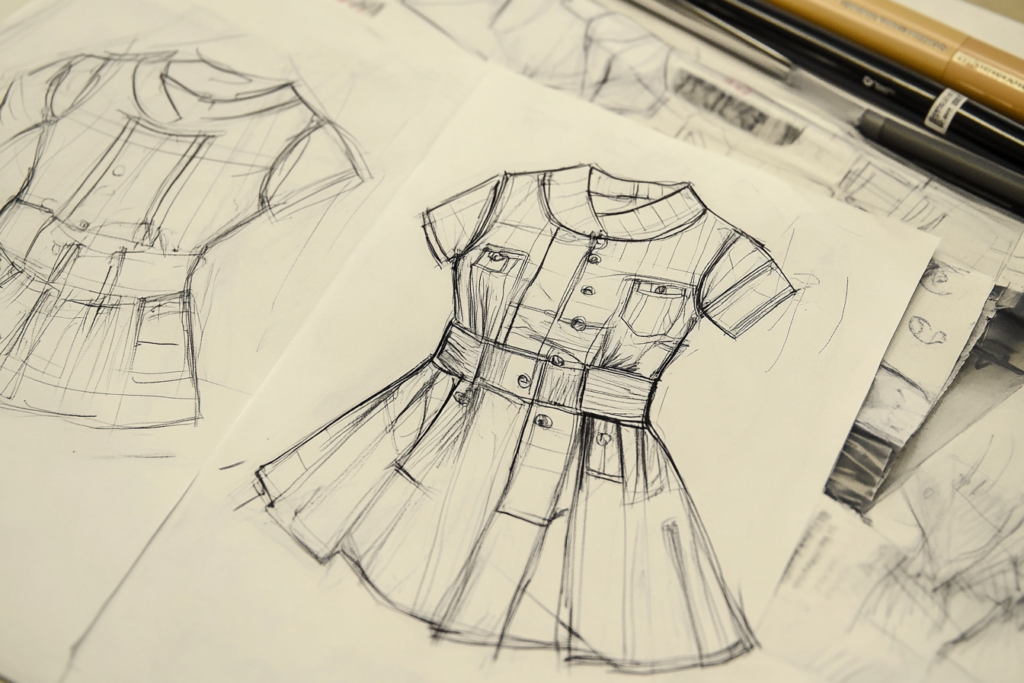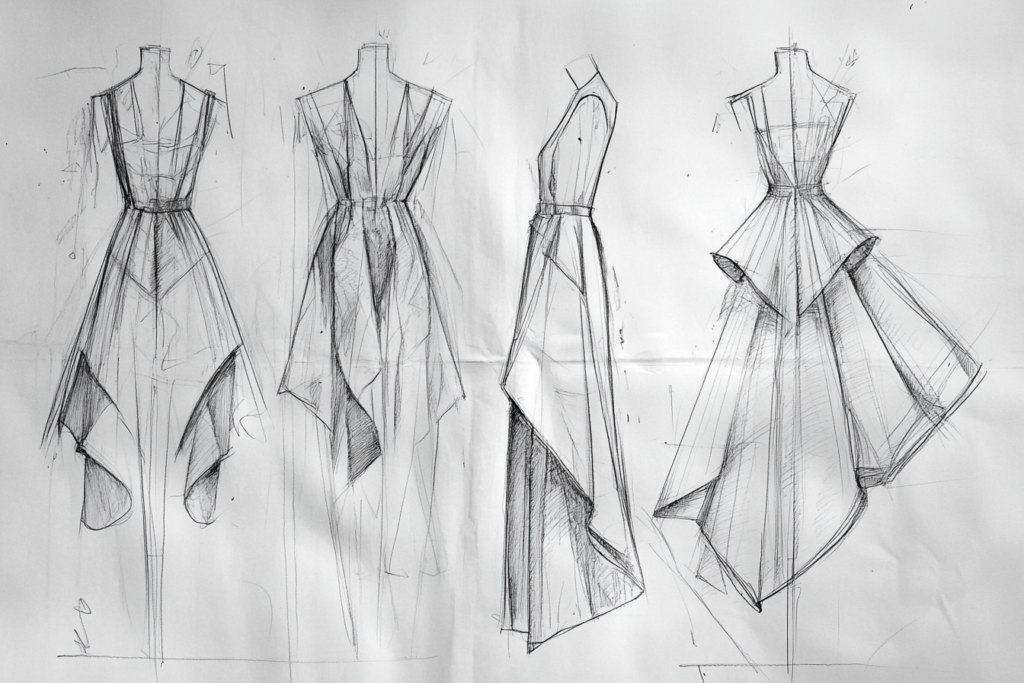Introduction: What is Croquis?
A croquis is a quick, loose sketch of a garment’s outline that is used by fashion designers, illustrators, and pattern makers to map out clothing designs. Often drawn on a human figure, croquis serves as the foundation for more detailed fashion illustrations and technical drawings. The primary goal of a croquis is to capture the basic structure and silhouette of the garment, helping designers visualize how it will look when worn.
Typically, croquis sketches are rough and freehand, focusing on proportions, lines, and key features of the garment rather than fine details. By using croquis, designers can rapidly explore different concepts, designs, and styles before committing to more refined work.


How is Croquis Used in Fashion Design?
- Sketching the Basic Silhouette:
- A croquis typically shows a simplified outline of the human form, often with exaggerated proportions (long legs, slim torso) to highlight the flow and cut of the garment. This basic outline allows designers to quickly visualize how their designs will fit the body.
- Exploring Design Ideas:
- Croquis sketches are used early in the design process to experiment with different silhouettes, lengths, and details. Designers often create several croquis variations to test different aspects of a garment, such as sleeve lengths, collar styles, or skirt shapes.
- Communication and Collaboration:
- Fashion designers use croquis sketches to communicate their ideas to team members, pattern makers, and manufacturers. It serves as a visual guide that helps the entire design team understand the garment’s concept before moving on to technical drawings or prototypes.
- Speed and Efficiency:
- Croquis sketches are quick to produce, enabling designers to iterate and modify their ideas efficiently. Since these sketches are not detailed or refined, designers can produce numerous ideas in a short amount of time, speeding up the conceptualization phase of design.
The Role of Croquis in Fashion Illustration
Fashion illustration is a key part of the fashion design process, and croquis is an essential tool in this field. Croquis sketches serve as the starting point for more polished illustrations, which are used in lookbooks, presentations, and marketing materials. In these more detailed illustrations, the proportions of the croquis are refined, and the garment’s fabric, texture, and intricate details are added.
Different Types of Croquis
- Flat Croquis:
- These sketches show the garment from the front or back, with little or no human figure. The focus is purely on the design and how the garment fits and moves. Flat croquis are commonly used when designing simple garments, like a jacket or dress.
- Fashion Figure Croquis:
- The fashion figure croquis is the most common type, where the sketch includes a stylized human figure. The proportions may be altered to create a more exaggerated and elongated appearance, which is typical in fashion illustration.
- Technical Croquis:
- Technical croquis are more detailed and are used for practical purposes such as pattern making. These sketches show the garment with clear details on construction, seams, stitching, and other technical aspects necessary for creating the actual garment.
Why is Croquis Important in Fashion Design?
- Faster Conceptualization:
- Croquis sketches help designers explore multiple design ideas quickly. Since the focus is on capturing the overall shape of the garment, designers can experiment with various silhouettes and styles without getting bogged down by intricate details.
- Inspiration and Innovation:
- By sketching out ideas through croquis, designers are able to visualize how different designs will look on a figure. This helps spark creativity and innovation by offering a clear visual representation of ideas that can evolve into full designs.
- Design Communication:
- Croquis sketches serve as a universal visual language for designers and their teams. Whether communicating with pattern makers or manufacturers, croquis provide a visual shorthand that helps designers communicate the concept and fit of a garment.
- Foundation for Detailed Work:
- Once a design concept has been finalized through croquis sketches, designers can begin working on more detailed illustrations, technical drawings, and patterns. This ensures that the final garment stays true to the designer’s original vision.
How to Draw a Croquis
- Start with the Basic Figure:
- Begin by sketching a simple, elongated human figure that serves as the base for the garment. You can either use a real-life model or a pre-drawn figure template.
- Outline the Garment:
- Next, draw the outline of the garment on the figure. Keep the sketch loose and avoid focusing too much on fine details, such as stitching or fabric texture.
- Focus on Proportions:
- The goal of the croquis is to capture the garment’s fit and silhouette, so pay close attention to how the garment moves with the figure’s proportions. Don’t worry about perfect anatomy—croquis often exaggerate proportions to highlight the design.
- Refine as Needed:
- After sketching the basic design, refine the lines and details where necessary, ensuring the design is clear and communicates the intended silhouette.
Conclusion: The Importance of Croquis in Fashion Design
The croquis serves as a vital tool for fashion designers by providing a quick and efficient way to sketch garment designs, explore different ideas, and communicate concepts to others in the design process. While it’s a simple and often rough sketch, it holds great importance in the world of fashion, acting as the first step towards bringing new designs to life.
Whether you’re a seasoned designer or a beginner, understanding how to use croquis will help you effectively communicate your ideas and create innovative, well-constructed designs.



